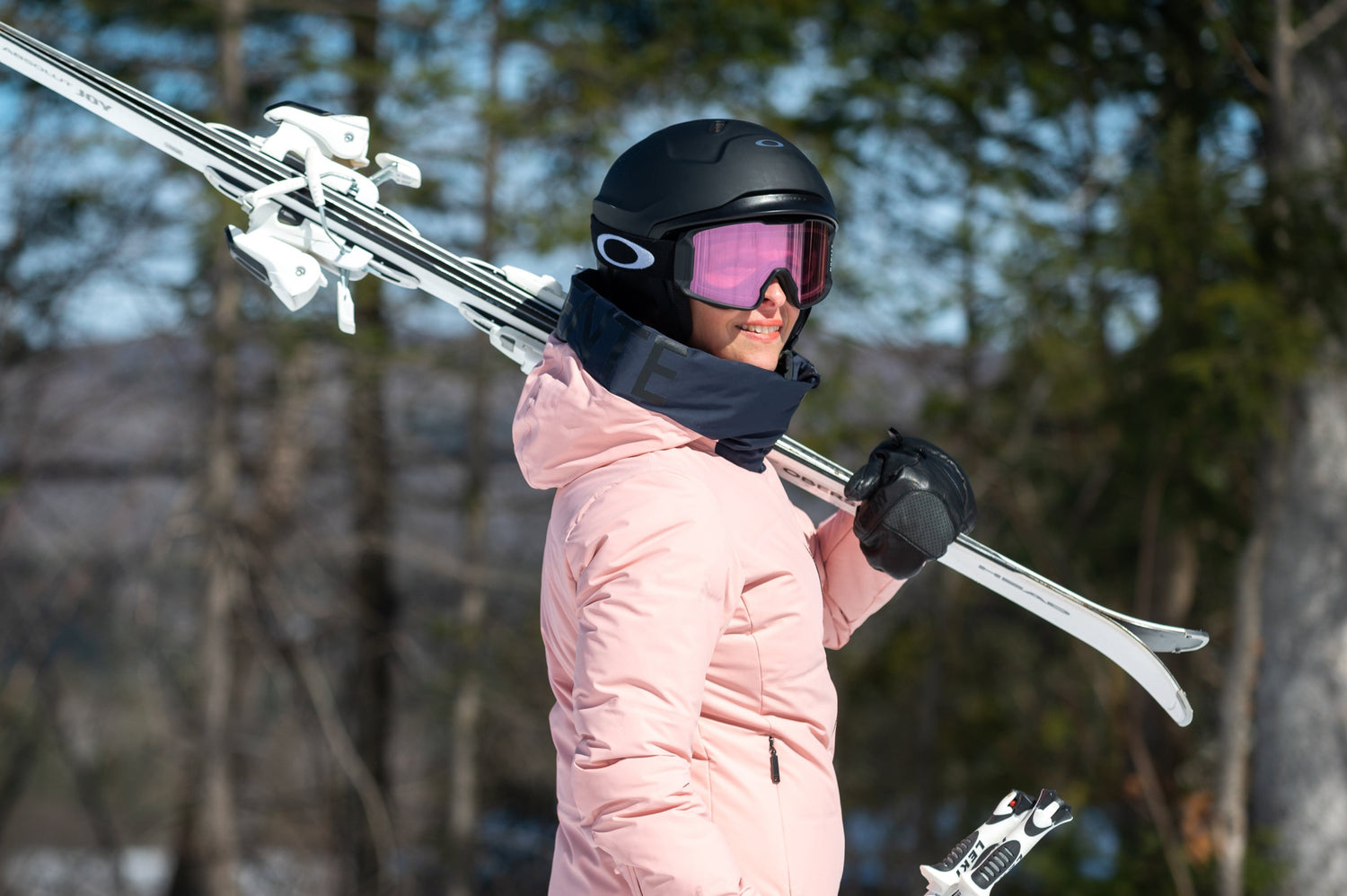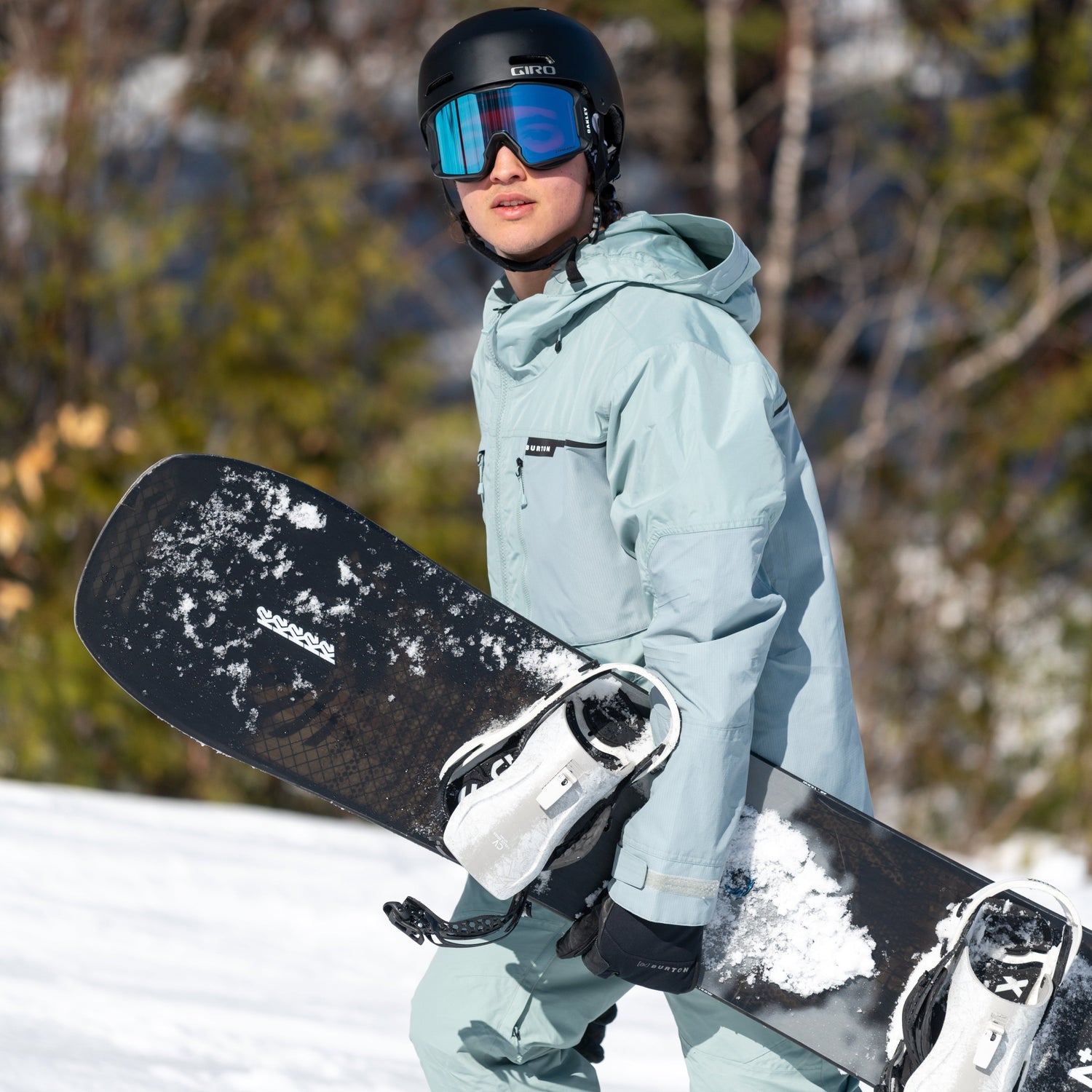Snowboard Gear
Snowboards
There are many models of snowboards for different skill levels and various terrain types. Snowboards are categorized in four styles: freestyle, all-mountain, freeride and splitboards.
Snowboards are made of a wood core, fibreglass and sometimes carbon. These materials give the board a flex rating, which reflects both its longitudinal and torsional flex. This affects how boards behave on different kinds of terrain. In addition, snowboards have a camber profile that also has an impact on their behaviour on snow. A softer board is perfect to start with because it’s easier to maneuver at low speeds and is more forgiving.
If you’re new to snowboarding or need advice for your next purchase, check out our article How to Choose a Snowboard.

Snowboard Boots
Snowboard boots are an extremely important piece of gear. They’re an integral part of your comfort and ensure maximum performance for your skill level.
Since snowboard boots are comfortable from the get-go, it’s common to think that they’re still in good condition even though you should change them. A boot that’s too comfortable often means you have a sagging liner that no longer provides the same support and performance as during its first descents. We recommend you change your boots every forty to sixty outings, especially if you ride regularly.
Snowboard boots are categorized by flex rating. This rating relates to your skill level and the terrain ridden. There are also different types of lacing, such as traditional lacing and the BOA® system.
Do you need new snowboard boots? Check out our article Choosing the Right Snowboard Boots.

Snowboard Bindings
Snowboard bindings are meant to connect you to your board. They consist of a highback, a footbed, an ankle strap and a toe strap. All of these parts influence the bindings’ flex rating, which—like the board and boots—have an impact on how the snowboard rides. That’s why flex is a critical aspect to consider when buying bindings because it’s closely related to skill level.
Softer bindings provide much more mobility, which is great for beginners or freestylers. Stiffer bindings, on the other hand, are highly responsive and offer an outstanding energy return that more advanced riders or freeride enthusiasts will appreciate. Bindings with a moderate flex rating, on the other hand, are highly versatile.
We recommended choosing a binding in line with the board’s flex rating to take full advantage of the equipment’s potential. However, it’s always matter of feel and comfort on the board when choosing bindings.
Snowboard Maintenance
A well-tuned snowboard is synonymous with fun! Sharp edges allow you to bite into hardened surfaces, while wax applied to the base makes for a smooth glide, especially on the long flat sections sometimes encountered at ski resorts. For everything you need to know about snowboard maintenance, read our tips.

Snowboard Clothing
Snowboard Jacket
A snowboard jacket is similar to a ski jacket. However, brands more associated with the snowboard industry design jackets with looser, more relaxed fits.
The jacket should be insulated with synthetic materials or down, waterproof, and breathable to ensure maximum comfort. Plus, certain features, such as zip pockets, an adjustable hood, and hem adjustments, are important features to check when making a purchase.
To learn more about what to wear snowboarding, read our article on winter clothing.

Snow Pants
The same goes for snowboard pants: they fit the same as ski pants. Your pants can be fully insulated or only in strategic places, such as the seat and thighs. They’re usually insulated with synthetic materials, such as Primaloft®, Thinsulate™ or a brand’s own insulation. The main thing is to be comfortable and choose an insulation that works for you.
Base Layers
Made with synthetic or natural materials, such as merino wool, the base layer’s purpose is to keep you warm and dry. It should be close-fitting and worn directly on the skin to be effective. It’s important to choose the right base layer according to the intensity of your activity. Your choice for touring won’t be the same as for riding at a resort. To choose the right base layers, see our article about base layers.

Mid Layers
Mid layers add a layer of warmth, even if your jacket is insulated. It can be a half-zip sweater or a light jacket made with wool or polypropylene. Also, when it’s downright frigid outside, an insulating layer such as a jacket or vest is a great option.
Ski Socks
Ski socks are a crucial part of your clothing. Even though snowboard boots are warm and comfortable, your feet can quickly cool off if your blood circulation isn’t great or moisture builds up. Ski socks are made with synthetic, natural materials that wick moisture and retain heat from your feet in snowboard boots. There are various types of cushioning: ultralight, light, medium and targeted. Compression socks are another option.

Gloves and Mittens
Keeping your hands warm is a key to enjoying days of riding! Mittens and gloves are designed to protect you against the winter wind and cold with an outer layer and insulation. Gloves and mittens can be insulated with down or synthetic materials. If your hands get cold quickly, go with mittens because they envelop all your fingers.
Beanies
A beanie is an essential for playing outside. If you wear a ski helmet, a thinner beanie or balaclava is a great choice to be comfortable. Otherwise, a hat of your choice can be worn to trap as much of your heat as possible.

Snowboard Accessories
Ski Helmets
We highly recommend wearing a ski helmet when you’re hitting the slopes. Made with a plastic shell and rigid foam, it protects your head from impacts during falls. When buying one, features like vents, additional protection technologies, such as MIPS®, and ski goggle compatibility are essential criteria to check.
It’s also important to try on multiple models since each brand fits differently. In other words, a brand can be very comfortable for one person, but not for another.
To help you choose your ski helmet, check out our article How to Choose the Right Ski Helmet.
Ski Goggles
Ski goggles are another form of protection and play a key role in a successful day or evening on the slopes. Lens tint plays a key role in eye comfort. Ski goggles not only protect your eyes, but they also allow you to analyze the terrain and obstacles and provide a clear, precise field of vision.
To fully understand ski goggles, see our article How to Choose Ski Goggles.




